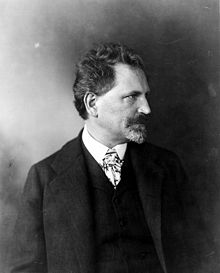Alphonse Mucha

Alfons Maria Mucha (or Alphonse Maria Mucha) (July 24, 1860–July 14, 1939) was a Czech painter and decorative artist.
Life and art
Alfons Maria Mucha was born in the town of Ivančice, Moravia. His singing abilities allowed him to continue his education through high school in the Moravian capital of Brno, even though drawing had been his first love since childhood. He worked at decorative painting jobs in Moravia, mostly painting theatrical scenery, then in 1879 moved to Vienna to work for a leading Viennese theatrical design company, while informally furthering his artistic education. When a fire destroyed his employer's business in 1881 he returned to Moravia, doing freelance decorative and portrait painting. Count Karl Khuen of Mikulov hired Mucha to decorate Hrušovany Emmahof Castle with murals, and was impressed enough that he agreed to sponsor Mucha's formal training at the Munich Academy of Fine Arts.

Mucha moved to Paris in 1887, and continued his studies at Académie Julian and Academie Colarossi while also producing magazine and advertising illustrations. In 1894, he produced the artwork for a lithographed poster advertising Sarah Bernhardt at the Theatre de la Renaissance. Mucha's lush stylized poster art won him fame and numerous commissions.
Mucha produced a flurry of paintings, posters, advertisements, and book illustrations, as well as designs for jewellery, carpets, wallpaper, and theatre sets in what came to be known as the Art Nouveau style. Mucha's works frequently featured beautiful healthy young women in flowing vaguely Neoclassical looking robes, often surrounded by lush flowers which sometimes formed haloes behind the women's heads. His art nouveau style was often imitated. However, this was a style that Mucha attempted to distance himself from throughout his life; he insisted always that, rather than adhering to any fashionable stylistic form, his paintings came purely from within. He declared that art existed only to communicate a spiritual message, and nothing more; hence his frustration at the fame he gained through commercial art, when he wanted always to concentrate on more lofty projects that would ennoble art and his birthplace.
Mucha visited the USA from 1906 to 1910, and the Society of Illustrators, then returned to the Czech lands and settled in Prague, where he decorated the Theater of Fine Arts and other landmarks of the city.
When Czechoslovakia won its independence after World War I, Mucha designed the new postage stamps, banknotes, and other government documents for the new nation.
He spent many years working on what he considered his masterpiece, The Slav Epic (Slovanská epopej), a series of huge paintings depicting the history of the Slavic peoples, bestowed to the city of Prague in 1928. He had dreamt of completing a series such as this, a celebration of Slavic history, since he was young.
The rising tide of fascism in the late 1930s led to Mucha's works, as well as his Slavic nationalism, being denounced in the press as 'reactionary'. When German troops marched into Czechoslovakia in the spring of 1939, Mucha was among the first people to be arrested by the Gestapo. During the course of the interrogation the aging artist fell ill with pneumonia. Though eventually released, he never recovered from the strain of this event, or seeing his home invaded and overcome. He died in Prague on July 14 of a lung infection, 1939 and was interred there in the Vyšehrad cemetery.
Legacy

By the time of his death, Mucha's style was considered outdated and old-fashioned. However, his son, author Jiří Mucha, devoted much of his life to writing about him and bringing attention to his art. Interest in Mucha's distinctive style experienced a strong revival in the 1960s (with a general interest in Art Nouveau)[1] and is particularly evident in the psychedelic posters of Hapshash and the Coloured Coat, the collective name for two British artists, Michael English and Nigel Waymouth, who designed posters for groups such as Pink Floyd and The Incredible String Band. It has continued to experience periodic revivals of interest for illustrators and artists. It is a strong acknowledged influence for Stuckist painter Paul Harvey whose subjects have included Madonna and whose work was used to promote The Stuckists Punk Victorian show at the Walker Art Gallery during the 2004 Liverpool Biennial.
Legal Controversy
A 1980's decision by Richard Posner involving Mucha's works and mentioning Mucha's life and work biographically is available here. [[2]]
